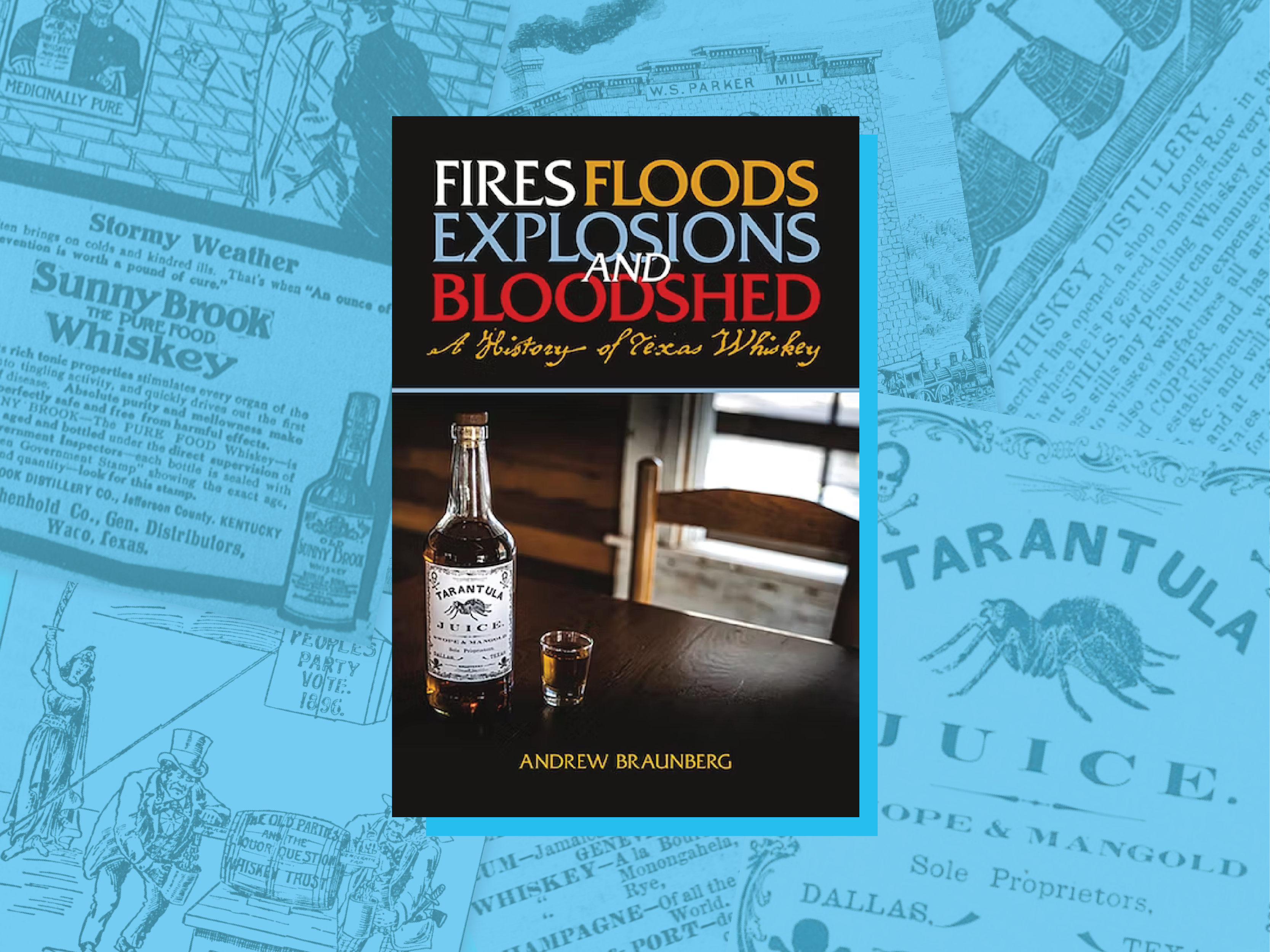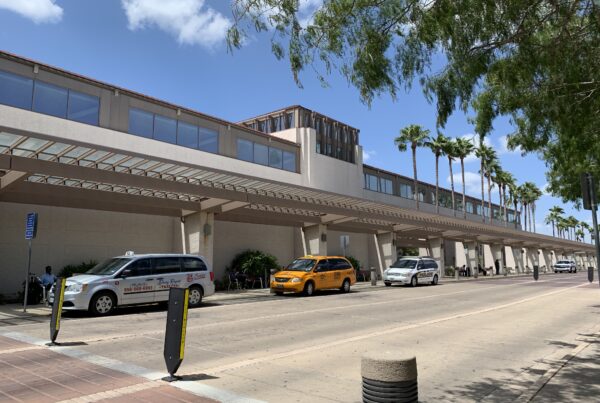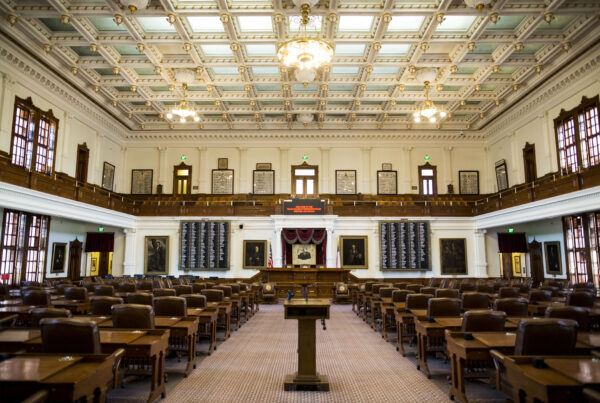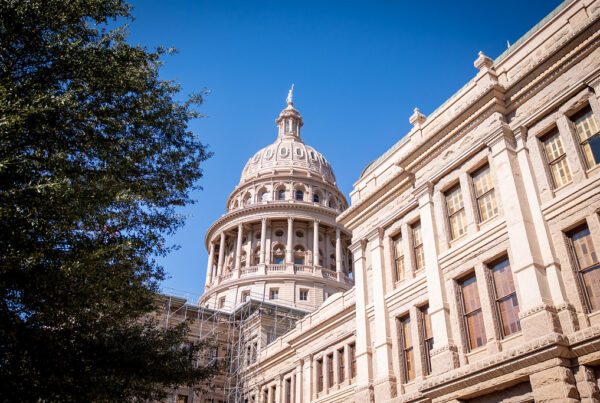In these days of craft spirits distilling, Texas whiskey makers have earned a reputation for innovative, high-end products. But it hasn’t always been this way. The history of whiskey in Texas is a raucous and complicated one.
You can get a taste of that history from the title of a new book by Austin-based distiller Andrew Braunberg: Fires, Floods, Explosions and Bloodshed: A History of Texas Whiskey. Braunberg told Texas Standard that Texans began producing spirits long before a commercial distilling industry existed. Listen to the interview above or read the transcript below.
This transcript has been edited lightly for clarity:
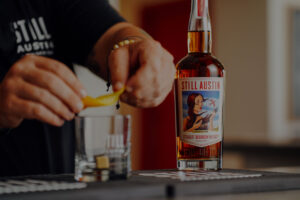
Author Andrew Braunberg is the co-founder of Still Austin Whiskey Co. Photo by Lisa Braunberg
Texas Standard: Why did you want to write about the history of Texas whiskey? What brought you to that place?
Andrew Braunberg: Well, I was doing some distilling. And honestly, the original impetus was to try to figure out what Texas distillers were making in the pre-Prohibition era. And it just struck me that it was really hard to find not even any general information about what these guys were up to, a little less kind of figuring out what their mash bill, as we call it – what kind of whiskey they were making. That was what got me down the rabbit hole.
Well, what did that rabbit hole bring up once you went looking for where Texans first began distilling spirits?
You know, deeper than I thought. I’ll tell you that. And I’m glad you said spirits, because there’s definitely a distinction between what was being made early – I mean, we can go back to the Spanish days in West Texas, and they were making brandy out there 400 years ago. The first ardent spirit, as they would have called it, in what we can say was modern Texas – which will go to Steve Austin’s colony – was a rum.
They were trying to do sugar cane plantations and they decided, “let’s try to further monetize some of this.” The whiskey didn’t take much longer. I mean, as people were migrating in – many of them by land, many of them coming from Southern and Appalachian states – we got whiskey being produced by the late 1830s.
You write the taxes from whiskey and other spirits have actually been a really important source of revenue for Texas’ government. And you say that in the modern era of whiskey production, well, you sort of draw a line with the first federal whiskey tax levied in 1862. Why is the way spirits are taxed so important to their history?
The issue around distilling particularly was not so much the tax, but the regulation that had to go with it. Building that infrastructure, post-Civil War to the end of the 1870s, it really changed the dynamics of who really wanted to jump through those hoops, were willing to put up with that kind of oversight. And that’s where we started getting more of an industrialization of the industry, because those typical frontier guys who would have a mill – they’d build a mill and then attach a distillery to it or a wood saw – steam operated – attached to that. Those guys started dropping out. So that was generally the biggest effect of that, although I have to say in Texas we kept it craft all the way through – a lot of small players that lasted quite a while.
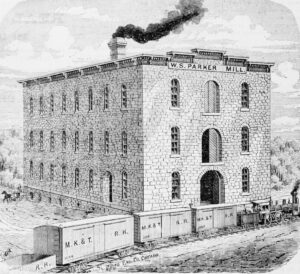
Courtesy of Andrew Braunberg and Statehouse Press
Well, your book title gives a clue about why Texas didn’t always live up to its potential as a hub for commercial distilling. You write about the Parker Distillery in Dallas – a promising enterprise – and a flood that destroyed it. Lots of other businesses had mishaps before they ever got off the ground, too, right?
Parker is just a heartbreaker. You know, this guy, the family come down from Iowa. They must have brought some cash with them because he really invested in Dallas. He understood the impact of the railroads. This is mid-1870s. Dallas, still a relatively small town, but he’s right down there on the Trinity, kind of where Dealey Plaza would be now, I think. He was adjacent to the tracks. He built a flour mill, a corn mill. He was building a cooperage and a distillery. They were all noted at the time as being some of the largest properties and businesses in Dallas. And he recognized that the railroad had not done a good job in trying to divert water away from their tracks. He kind of predicted what would happen, and then he got completely washed out. And if not for that, I think the whole history of Texas distilling would have been different.
I was surprised to learn that, contrary to Texas’ modern reputation, Texas was sort of ahead of the curve – certainly ahead of the feds – when it came to some pretty significant pure food laws. How did that affect whiskey here?
I gotta tell you, it’s hard to explain the centrality of whiskey to that Pure Food and Drug Act and the kind of controversy that followed. That’s 1906 when it passes. First it was Teddy Roosevelt’s administration, and then it got reopened during the Taft administration. It really watered down what the definition of whiskey would be. And in Texas, [the responsible official] would be the Food and Dairy commissioner. You needed someone to enforce those laws. And in Texas, there was this young guy. He was still in his twenties. He had been a chemistry teacher up in Dallas. I think when they found him, his name was John Simpson Abbott. And Abbott liked good whiskey and he wasn’t willing to compromise. He made it clear, I mean directly to President Taft himself, at least via correspondence, that Taft Whiskey would not do in Texas, and they were not going to allow it.
But the interesting thing from my point of view is that there were no real distillers left in Texas at that point. There were only rectifiers and the only people this was going to annoy in Texas were the rectifier. So it seems like he did it completely out of principle. He was just a man who liked good whiskey, and he used the pharmacopeia definition to define it. It was a really solid benchmark, better than we have today.
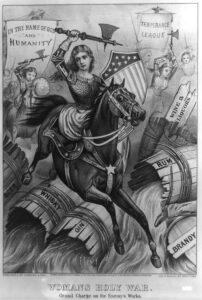
Courtesy of Andrew Braunberg and Statehouse Press
Of course, then you have Prohibition. It kind of came to Texas early and stayed late, which I found to be curious.
Yeah. So everybody likes to point the finger at Texas for Prohibition. And so the reason for that mostly has to do with Texas senator Morris Sheppard. Sheppard was a lifelong proponent of Prohibition. He was a progressive Democrat of the time and Prohibition became a big progressive issue. So he was kind of on track with his party. But I guess as far as coming earlier, it was really something that had been agitated for really going back. You could go back to the 1850s, for example, when the first wave of Prohibition hit. But that was really more a New England thing. Texas was one of the few states that implemented any kind of statewide Prohibition, even that early – one of the few southern or western states. And by 1890, probably most of the counties had been drying out in Texas. We went through Prohibition again. Sheppard authored the Eighteenth Amendment, which is what sealed the deal, among other really important Prohibition legislation. But to your point on long-lasting, I think Prohibitionists did such a good job demonizing the saloon that you couldn’t get a mixed drink in Texas until 1970. When I found that out, I couldn’t believe it.
Now as I mentioned when we started things out, Texas has become a real center for a lot of craft distilling. Why has that happened here, do you think?
Well, I think there’s a lot of entrepreneurship in Texas, and that continues, right? I think that was true then, which is a kind of nice throughline for this, and I think it’s true now. Texas has got some advantages. We’ve got cheap energy down here. We’ve got great agriculture. I mean, most of the grains you’re going to use – corn, wheat, rye – all grow really well in Texas and prices are pretty good. Barley is a little more of a cold weather crop, but we still get some barley here.
I think folks, when they embraced craft distilling, Texas generally didn’t jump into craft whiskey as early as they did in many states. I mean, we had Tito [Beveridge] out there making vodka. But whiskey, I think, not as recently – maybe 15 years. But the idea I think early was that given the environment – the heat, humidity or dryness, depending on where you are in the state – could probably offer up some differentiation from some of the other states. And we’re seeing that very much in some of the Texas whiskey.
What do you think the outlook is for Texas as a whiskey-making state, looking out into the future?
Yeah, this is a question I think a lot of people have on their mind, like how far does this go? Do these distilleries just keep becoming part of these larger brands, which has happened a bit, or do we get some real long-term Texas brands? I’m kind of in the second camp, but I think you’re going to have folks that are going to become really kind of dominant players. I think Texas will become one of the major whiskey producers in the United States, and I think we’ll start seeing these regional variations, much like they have in Scotland. You got your Highlands, your Midlands, and the islands – different flavor profiles. When you go to the liquor store, you’ll go to the Texas section and you’ll find what you want. Or you’ll go to the Colorado section or the Pacific Northwest. But I think Texas will be a major player.


